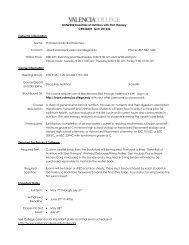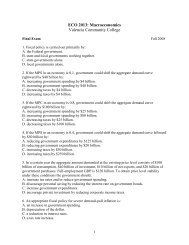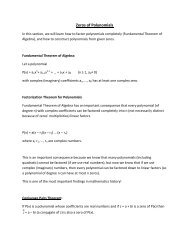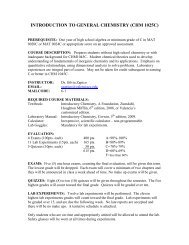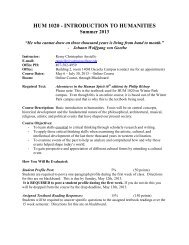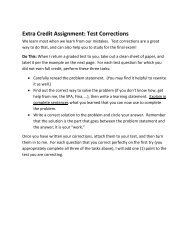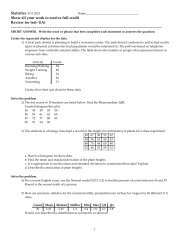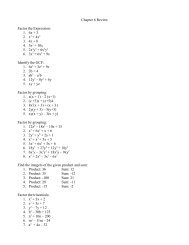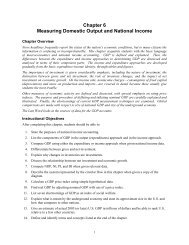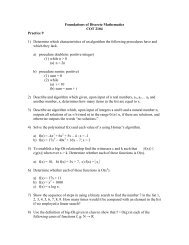Chapter 3
Chapter 3
Chapter 3
Create successful ePaper yourself
Turn your PDF publications into a flip-book with our unique Google optimized e-Paper software.
LECTURE PRESENTATIONS<br />
For CAMPBELL BIOLOGY, NINTH EDITION<br />
Jane B. Reece, Lisa A. Urry, Michael L. Cain, Steven A. Wasserman, Peter V. Minorsky, Robert B. Jackson<br />
<strong>Chapter</strong> 3<br />
Water and Life <br />
Lectures by<br />
Erin Barley<br />
Kathleen Fitzpatrick<br />
© 2011 Pearson Education, Inc.
Overview: The Molecule That Supports<br />
All of Life<br />
• Water is the biological medium on Earth<br />
• All living organisms require water more than any<br />
other substance<br />
• Most cells are surrounded by water, and cells<br />
themselves are about 70–95% water<br />
• The abundance of water is the main reason the<br />
Earth is habitable<br />
© 2011 Pearson Education, Inc.
Figure 3.1
Concept 3.1: Polar covalent bonds in water<br />
molecules result in hydrogen bonding<br />
• The water molecule is a polar molecule: the<br />
opposite ends have opposite charges<br />
• Polarity allows water molecules to form hydrogen<br />
bonds with each other<br />
Animation: Water Structure<br />
© 2011 Pearson Education, Inc.
Figure 3.2<br />
δ -<br />
δ +<br />
Hydrogen<br />
bond<br />
δ +<br />
δ -<br />
δ +<br />
δ -<br />
δ +<br />
δ -<br />
Polar covalent<br />
bonds
Figure 3.UN01
Concept 3.2: Four emergent properties of<br />
water contribute to Earth’s suitability for life<br />
• Four of water’s properties that facilitate an<br />
environment for life are<br />
– Cohesive behavior<br />
– Ability to moderate temperature<br />
– Expansion upon freezing<br />
– Versatility as a solvent<br />
© 2011 Pearson Education, Inc.
Cohesion of Water Molecules<br />
• Collectively, hydrogen bonds hold water<br />
molecules together, a phenomenon called<br />
cohesion<br />
• Cohesion helps the transport of water against<br />
gravity in plants<br />
• Adhesion is an attraction between different<br />
substances, for example, between water and<br />
plant cell walls<br />
Animation: Water Transport<br />
© 2011 Pearson Education, Inc.
Figure 3.3<br />
Adhesion<br />
Two types of<br />
water-conducting<br />
cells<br />
Direction<br />
of water<br />
movement<br />
300 µm<br />
Cohesion
Figure 3.3a<br />
Two types of<br />
water-conducting<br />
cells<br />
300 µm
• Surface tension is a measure of how hard it is<br />
to break the surface of a liquid<br />
• Surface tension is related to cohesion<br />
© 2011 Pearson Education, Inc.
Figure 3.4
Moderation of Temperature by Water<br />
• Water absorbs heat from warmer air and<br />
releases stored heat to cooler air<br />
• Water can absorb or release a large amount of<br />
heat with only a slight change in its own<br />
temperature<br />
© 2011 Pearson Education, Inc.
Heat and Temperature<br />
• Kinetic energy is the energy of motion<br />
• Heat is a measure of the total amount of kinetic<br />
energy due to molecular motion<br />
• Temperature measures the intensity of heat<br />
due to the average kinetic energy of molecules<br />
© 2011 Pearson Education, Inc.
Water’s High Specific Heat<br />
• The specific heat of a substance is the amount of<br />
heat that must be absorbed or lost for 1 g of that<br />
substance to change its temperature by 1ºC<br />
• The specific heat of water is 1 cal/g/ºC<br />
• Water resists changing its temperature because of<br />
its high specific heat<br />
© 2011 Pearson Education, Inc.
• Water’s high specific heat can be traced to<br />
hydrogen bonding<br />
– Heat is absorbed when hydrogen bonds break<br />
– Heat is released when hydrogen bonds form<br />
• The high specific heat of water minimizes<br />
temperature fluctuations to within limits that permit<br />
life<br />
© 2011 Pearson Education, Inc.
Figure 3.5<br />
Santa Barbara 73°<br />
70s (°F)<br />
80s<br />
90s<br />
100s<br />
Los Angeles<br />
(Airport) 75°<br />
Burbank<br />
90°<br />
Pacific Ocean 68°<br />
San Diego 72°<br />
Santa Ana<br />
84°<br />
San Bernardino<br />
100°<br />
Riverside 96°<br />
Palm Springs<br />
106°<br />
40 miles
Evaporative Cooling<br />
• Evaporation is transformation of a substance from<br />
liquid to gas<br />
• Heat of vaporization is the heat a liquid must<br />
absorb for 1 g to be converted to gas<br />
• As a liquid evaporates, its remaining surface<br />
cools, a process called evaporative cooling<br />
• Evaporative cooling of water helps stabilize<br />
temperatures in organisms and bodies of water<br />
© 2011 Pearson Education, Inc.
Floating of Ice on Liquid Water<br />
• Ice floats in liquid water because hydrogen bonds<br />
in ice are more “ordered,” making ice less dense<br />
• Water reaches its greatest density at 4°C<br />
• If ice sank, all bodies of water would eventually<br />
freeze solid, making life impossible on Earth<br />
© 2011 Pearson Education, Inc.
Figure 3.6<br />
Hydrogen bond<br />
Liquid water:<br />
Hydrogen bonds<br />
break and re-form<br />
Ice:<br />
Hydrogen bonds<br />
are stable
Figure 3.6a
Water: The Solvent of Life<br />
• A solution is a liquid that is a homogeneous<br />
mixture of substances<br />
• A solvent is the dissolving agent of a solution<br />
• The solute is the substance that is dissolved<br />
• An aqueous solution is one in which water is<br />
the solvent<br />
© 2011 Pearson Education, Inc.
• Water is a versatile solvent due to its polarity,<br />
which allows it to form hydrogen bonds easily<br />
• When an ionic compound is dissolved in water,<br />
each ion is surrounded by a sphere of water<br />
molecules called a hydration shell<br />
© 2011 Pearson Education, Inc.
Figure 3.7<br />
Na +<br />
+<br />
Na +<br />
+<br />
Cl - Cl -<br />
-<br />
-<br />
-<br />
+<br />
-<br />
-<br />
-<br />
+<br />
+<br />
+<br />
-<br />
+<br />
-<br />
-<br />
-<br />
-<br />
+
• Water can also dissolve compounds made of<br />
nonionic polar molecules<br />
• Even large polar molecules such as proteins can<br />
dissolve in water if they have ionic and polar<br />
regions<br />
© 2011 Pearson Education, Inc.
Figure 3.8<br />
δ +<br />
δ -<br />
δ -<br />
δ +
Hydrophilic and Hydrophobic Substances<br />
• A hydrophilic substance is one that has an<br />
affinity for water<br />
• A hydrophobic substance is one that does not<br />
have an affinity for water<br />
• Oil molecules are hydrophobic because they<br />
have relatively nonpolar bonds<br />
• A colloid is a stable suspension of fine particles<br />
in a liquid<br />
© 2011 Pearson Education, Inc.
Solute Concentration in Aqueous Solutions<br />
• Most biochemical reactions occur in water<br />
• Chemical reactions depend on collisions of<br />
molecules and therefore on the concentration of<br />
solutes in an aqueous solution<br />
© 2011 Pearson Education, Inc.
• Molecular mass is the sum of all masses of all<br />
atoms in a molecule<br />
• Numbers of molecules are usually measured in<br />
moles, where 1 mole (mol) = 6.02 x 10 23<br />
molecules<br />
• Avogadro’s number and the unit dalton were<br />
defined such that 6.02 x 10 23 daltons = 1 g<br />
• Molarity (M) is the number of moles of solute per<br />
liter of solution<br />
© 2011 Pearson Education, Inc.
Concept 3.3: Acidic and basic conditions<br />
affect living organisms<br />
• A hydrogen atom in a hydrogen bond between<br />
two water molecules can shift from one to the<br />
other<br />
– The hydrogen atom leaves its electron behind<br />
and is transferred as a proton, or hydrogen<br />
ion (H + )<br />
– The molecule with the extra proton is now a<br />
hydronium ion (H 3 O + ), though it is often<br />
represented as H +<br />
– The molecule that lost the proton is now a<br />
hydroxide ion (OH – )<br />
© 2011 Pearson Education, Inc.
• Water is in a state of dynamic equilibrium in<br />
which water molecules dissociate at the same<br />
rate at which they are being reformed<br />
© 2011 Pearson Education, Inc.
Figure 3.UN02<br />
+ -<br />
2 H 2 O Hydronium Hydroxide<br />
ion (H 3 O + ) ion (OH - )
• Concentrations of H + and OH – are equal in pure<br />
water<br />
• Adding certain solutes, called acids and bases,<br />
modifies the concentrations of H + and OH –<br />
• Biologists use something called the pH scale to<br />
describe whether a solution is acidic or basic<br />
(the opposite of acidic)<br />
© 2011 Pearson Education, Inc.
Acids and Bases<br />
• An acid is any substance that increases the H +<br />
concentration of a solution<br />
• A base is any substance that reduces the H +<br />
concentration of a solution<br />
© 2011 Pearson Education, Inc.
The pH Scale<br />
• In any aqueous solution at 25°C the product of H +<br />
and OH – is constant and can be written as<br />
• The pH of a solution is defined by the negative<br />
logarithm of H + concentration, written as<br />
• For a neutral aqueous solution, [H + ] is 10 –7 , so<br />
© 2011 Pearson Education, Inc.<br />
[H + ][OH – ] = 10 –14<br />
pH = –log [H + ]<br />
pH = –(–7) = 7
• Acidic solutions have pH values less than 7<br />
• Basic solutions have pH values greater than 7<br />
• Most biological fluids have pH values in the range<br />
of 6 to 8<br />
© 2011 Pearson Education, Inc.
Figure 3.10<br />
pH Scale<br />
0<br />
1<br />
Battery acid<br />
H + H +<br />
H +<br />
H + OH -<br />
OH - H + H +<br />
H + H +<br />
Acidic<br />
solution<br />
OH -<br />
OH -<br />
H + H + OH -<br />
OH - OH -<br />
H +<br />
H + H +<br />
Neutral<br />
solution<br />
OH -<br />
OH -<br />
OH - H + OH -<br />
OH - OH -<br />
H + OH -<br />
Basic<br />
solution<br />
Increasingly Acidic<br />
[H + ] > [OH - ]<br />
Neutral<br />
[H + ] = [OH - ]<br />
Increasingly Basic<br />
[H + ] < [OH - ]<br />
2<br />
3<br />
4<br />
5<br />
6<br />
7<br />
8<br />
9<br />
10<br />
11<br />
12<br />
13<br />
14<br />
Gastric juice, lemon juice<br />
Vinegar, wine,<br />
cola<br />
Tomato juice<br />
Beer<br />
Black coffee<br />
Rainwater<br />
Urine<br />
Saliva<br />
Pure water<br />
Human blood, tears<br />
Seawater<br />
Inside of small intestine<br />
Milk of magnesia<br />
Household ammonia<br />
Household<br />
bleach<br />
Oven cleaner
Buffers<br />
• The internal pH of most living cells must remain<br />
close to pH 7<br />
• Buffers are substances that minimize changes<br />
in concentrations of H + and OH – in a solution<br />
• Most buffers consist of an acid-base pair that<br />
reversibly combines with H +<br />
© 2011 Pearson Education, Inc.



